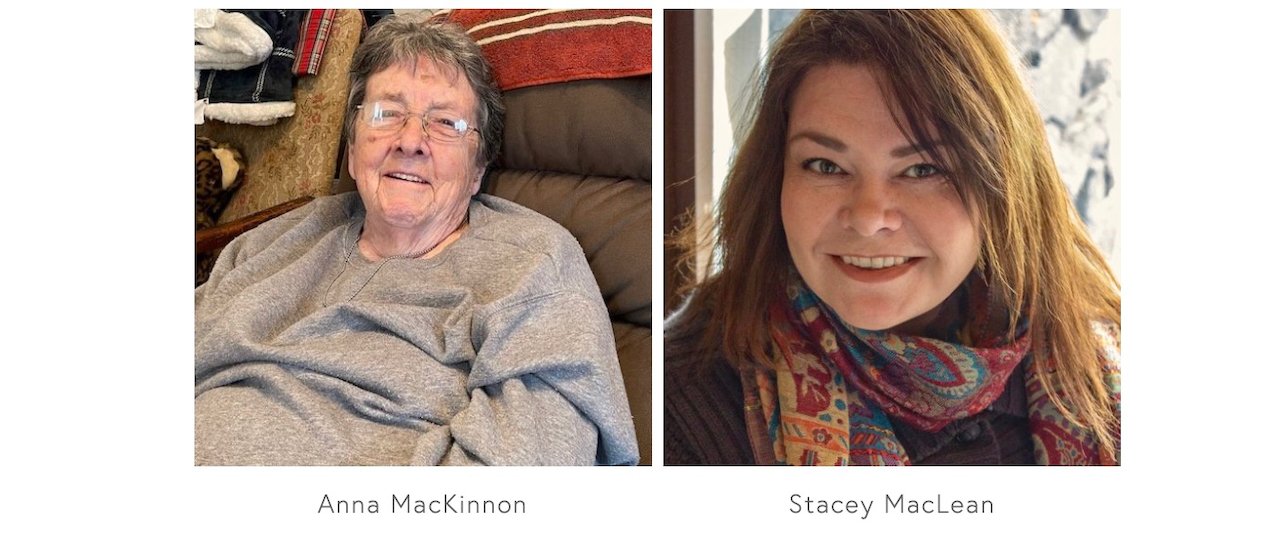Gifts of re-membering
March 10, 2023
Host: Shannon MacMullin
Guests: Anna MacKinnon, Stacey MacLean
Cuimhnich air na daoine bho 'n d' thàinig thu. | Remember those you came from.
What gifts are given and received in remembering those who have passed on? Are they too re-membered? Who have been the mnathan-ghlùine | midwives, who have guided our re-membering? What have they taught us about the importance of re-membering?
When we remember our language, songs, stories, history and traditions, we find that we ourselves are re-membered back into the ongoing stream of Gaelic life.
In this visit, Shannon MacMullin shared remembrances and moments of her beloved muime | foster grandmother, Annag ni'n Iain Alasdair 'ic Aonghais Ailein | Anna MacKinnon, who "joined" by video sharing. Shannon was then joined live by present-day bean-ghlùine of Gaelic tradition, Steiseag NicIlleathain | Stacey MacLean, who shared her stories of re-membering—the Gaels who welcomed and mentored her, and the ways Gaelic language and culture initiated her into the ongoingness of Gaelic life.
What we heard
Shannon began by introducing a video of her mentor, Anna MacKinnon, (Annag ni'n Iain Alasdair 'ic Aonghais Ailein ) of Inverness, Cape Breton: “She is one of the many who have offered me a shoulder to stand on, and I carry her with me in so many ways."
Anna and Shannon got to know each other through the Bun is Bàrr (Root and Branch) mentorship program, where Anna shared all she knew so willingly with the eager apprentice. In the video Anna speaks about her love of her language, how she persevered when people mocked her for speaking her language, and also her love and fond memories of her home in Rubh' an t-Seallaidh (Sight Point).
Shannon then welcomed a Gaelic-speaking contemporary, Stacey MacLean, who shared stories of her mentor Norman MacKillop (Tormad Dhòmhnaill Nìll) of Berneray, Scotland, where she stayed in the 1990s.
Stacey said that MacLeod, MacKillop and MacIver were common family names on the Island and they felt a strong affinity to the Norse part of their heritage, which dates back to before the Middle Ages.. "And he (Norman) would speak about them as if they were his cousins, that he knew them when he was young," she recalls.
After being shown a clip of Tormad speaking on a program about Oidhche Challuinn or New Years in Berneray, Stacey says one of her great regrets is that she never recorded him. However, she never thought of it as she was just living her life with Berneray Gaels. Learning Gaelic wasn't even why she went there, it was a by-product of living there. She just wanted to be among the Gaels.
"It was very much a living thing for me. I didn't feel the need to preserve anything. I wish I did."
She recalls him taking her around the Island and telling her stories about people and history connected to particular landmarks or communities. "It was so important to him that I remember, and I loved being quizzed . . . and we fed off each other. He got such a boost out of me remembering things, and I would get a boost out of him wanting to gift them to me."
Another gift that Tormad gave to her was a World War II sewing kit that his mother made for him.
"And that is probably the most precious thing that I have," she says. "It was very important to him, and for him to give it to me is . . . oh my goodness."
On a visit back to Scotland a few years ago, Stacey said she had to go back to Berneray, a place that was always on her mind. But when she came into Lochmaddy pier, she couldn't smell the peat that she smelled when she went back to visit Norman while living in Scotland.
"And that was me on the way home, as it were. Norman used to say to me all the time—he would call me once a week when I was in Sabhal Mor, and he'd write me a letter, no matter where I was in the world—and he would say Cuine tha thu a' tighinn dhachaidh?" (When are you coming home?).
"And when I went back I expected to go home, and it was because those people weren't there, especially him, that it didn't feel like home."
On this trip she stayed with Norman's neighbour, Duncan MacKinnon, who gave her a key to her Norman's home.
"I got very excited. I went to the house and I was devastated, because I stupidly thought everything would be the same. But it was gutted. It was devastating."
Her one solace on the trip was that Duncan's house smelled like Norman's. "I would pay for that smell," she said.
Staying on the theme of the senses to evoke memories, Stacey said if she were to sum up her experience with Norman by describing it as a food, she would connect it with potatoes. Berneray was known for its fluffy, white potatoes that they grew in the machair, which is a mixture of sand and soil. Prince Charles even went there on a crofting holiday to farm potatoes. Sometimes they'd have potatoes a few times a day, mixed with butter, curds or crowdie, and raw onion, which islanders believed was very good for you.
"I ate raw onion three times a day and I loved it. . . It was so simple! And I associated that with nourishment, in so many senses of the word. And as the weeks progressed, my fingertips would smell like onions."
She was careful not to totally wash the scent away. "I might have stunk to whoever wants you to smell like ylang ylang roses, but I wanted to smell like onions. I associate it with that time."
Stacey said it surprised her at first how present and relevant history was for the Gaels. "How it wasn't something that was off in the distant past that could only be understood in books, but was lived and re-told all the time."
She also loved the social ease offered by Gaelic culture, a bit different from what she experienced growing up in Dartmouth. When she was a teenager she stayed occasionally with Kay Bryden of Castlebay, whose home also evoked memories, this time of a wood-fired stove in an uninsulated home.
Some mornings she would lie on the grate that let the heat rise to the second floor and watch the comings and goings in Kay's kitchen.
"The laughing and the smell of the biscuits, and it was all connected. It was this wonderful celebration of life and community.
"Another thing that struck me very young is that there was absolutely no difference between the relationship you would have with someone who is 18 or 88. It all can nourish you in different ways and nourish them. That was really special, because I went to a high school of 1500 students where everyone was in their cliques and no one had to get along with anyone they didn't get along with. And I went to an area (Castlebay) where you were in with people of all different ages and people of various abilities, and the language and everyone was included. And I think that was something that was never thought about by them but was so deeply ingrained that it flowed naturally."
Shannon mentioned the reality that we are losing our elders who are aging and dying, and the grief and difficulty that goes with it. She asks Stacey about her grief and how she keeps going in the face of it.
Stacey mentioned two kinds of pain: a pain that is inflicted that you would rather not remember, and then there's heartache, that means you lost something you loved greatly. That you tend to continue celebrating. She said talking about it on the Gaelic Narrative Project is celebrating Gaels and their culture, or attending events like she did recently, where they only spoke Gaelic at a professional training weekend for Gaelic teachers.
"I so appreciate being part of this community because it continues to nourish me. . . I enjoy it so much. It's my favorite thing in the entire world to do and my favorite people to be around. I feel a kinship to them."
Teaching the children at Taigh Sgoile nan Drochaide the words that Norman wanted her to remember, or those she learned from another mentor, Angie Farrell (Benacadie, Cape Breton), and others is satisfying.
"There's no monuments to these people. . . It's so important that when you talk about these people, you are honoring them and memorializing them, not in a way that is a burden, but a celebration."
What we said
Some of our comments were shared in the chat stream during the conversation with the guests. Then, in the breakout rooms, we all responded to the stories we’d heard, and shared our own reflections. When we returned to the main room, we wrote some highlights and themes in the chat stream. Read all our comments.


